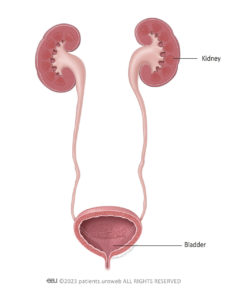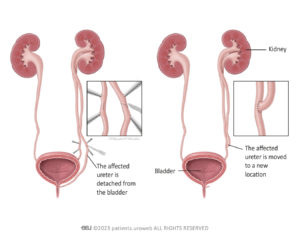What are ectopic ureters?
An ectopic ureter is when the ureter doesn’t connect to the bladder in the usual place. Instead, it can connect into different places, such as the vagina or the urethra (the wee tube that runs from the bladder and out of the body). This often causes urine to build up as it cannot drain like it should. This can lead to problems such as ureteral enlargement, where the ureter swells up.
Ectopic ureters can increase the risk of UTIs or urinary incontinence (uncontrolled loss of urine).
Ectopic ureter is a rare condition that affects around 10 out of 19,000 children. It is more commonly diagnosed in girls, because it tends to have a larger impact on their health and wellbeing. For instance, in girls, the ectopic ureter can connect to an unusual location, such as the vagina and can result in urinary incontinence.
An ectopic ureter is also more frequently seen in children who have duplex kidney. In some cases, children with an ectopic ureter may not experience any symptoms at all, making it challenging to determine the actual number of children with the condition.
What are the symptoms of ectopic ureters?
Many children with ectopic ureters don’t experience any symptoms at all, but for those children who do, the following are known symptoms of the condition:
Ectopic ureters can result in a slower flow of urine which can increase the risk of bacteria reaching the kidneys or bladder and therefore a higher chance of developing UTIs. It’s important to be familiar with the signs of a UTI, as prompt medical treatment is necessary to avoid damage to the kidneys.
In children over the age of 6 years, symptoms can include a burning sensation while weeing, a frequent need to wee, cloudy or foul-smelling urine and discomfort in their abdomen.
It can be very difficult to identify a UTI in younger children and babies as they may not appear to have these symptoms or they may only have a high temperature. However, you may notice your child is more unsettled or they have gone off their food. If you suspect your child has a UTI, it is important to take them to see their doctor to receive a diagnosis and so that antibiotics can be prescribed, if needed.
In girls, an ectopic ureter can attach to the vagina or the urethra and may not connect near the muscle that controls urine flow. This can cause urinary incontinence, which means that your child may have difficulty holding their urine and may leak it by accident.
Although boys can experience urinary incontinence, it is unlikely to be caused by an ectopic ureter.
What treatments are available for ectopic ureter?
The type of treatments that are offered depend on the specific condition, your child’s age, overall symptoms, urine flow, kidney function and medical history.
Non-Surgical Treatments
If your child keeps getting UTIs, your doctor may prescribe antibiotics. Antibiotics work to kill the bacteria causing the infection and help reduce any discomfort.
Surgical Treatments
Surgery for ectopic ureter is carried out under general anaesthesia. This is where your child is given medication to send them to sleep. Once they are asleep, they do not feel anything, nor will they remember the operation.
After the procedure, your child will be taken to the recovery area and closely monitored. Your healthcare team will provide instructions on wound care, pain management and any potential dietary or activity restrictions. It’s important to follow these instructions so that your child has a good recovery.
If ectopic ureters are causing blockages or other urinary issues, your doctor may recommend a ureteropyelostomy (pronounced:‘yur-reet-ero-pie-los -tomee’).
The aim of this surgery is to create a direct connection between the ectopic ureter and a specific part of the kidney called the renal pelvis, to help urine to flow properly from the kidney to the bladder. It’s an option in cases with duplex ureters or where a person has specific issues with the lower portion of their ureter.
This surgery is performed when ectopic ureters are causing significant complications.
The surgeon makes a small cut in the lower abdomen to access the bladder and carefully detaches the affected ureter from the bladder and moves it to a new location to improve the flow of urine from the kidneys to the bladder and prevent any blockages or urine reflux.
A heminephro-ureterectomy (pronounced:‘hem–ee-neff-roe your-reet-er-rec-tomee’) is an operation to remove part of the kidney and one of the ureters, if the kidney and ureter are not functioning properly. The aim of surgery is to improve how the kidney works and prevent any further complications.
During the procedure, the surgeon makes a small cut in the abdomen or side of the body to access the kidney. They identify and remove the part of the kidney that is causing problems, as well as the ureter connected to it.
If an ectopic ureter is causing problems by draining urine into the urethra, reproductive organs, or other areas, your doctor may recommend a ureteroureterostomy (pronounced:‘yur-reet-ero-yur-reet-er-ost-omee’). This procedure involves the surgeon connecting the 2 ends of the same ureter to the correct places, allowing urine to flow properly from the kidney down to the bladder.
This surgery aims to improve urine drainage, prevent complications and protect the kidney.




